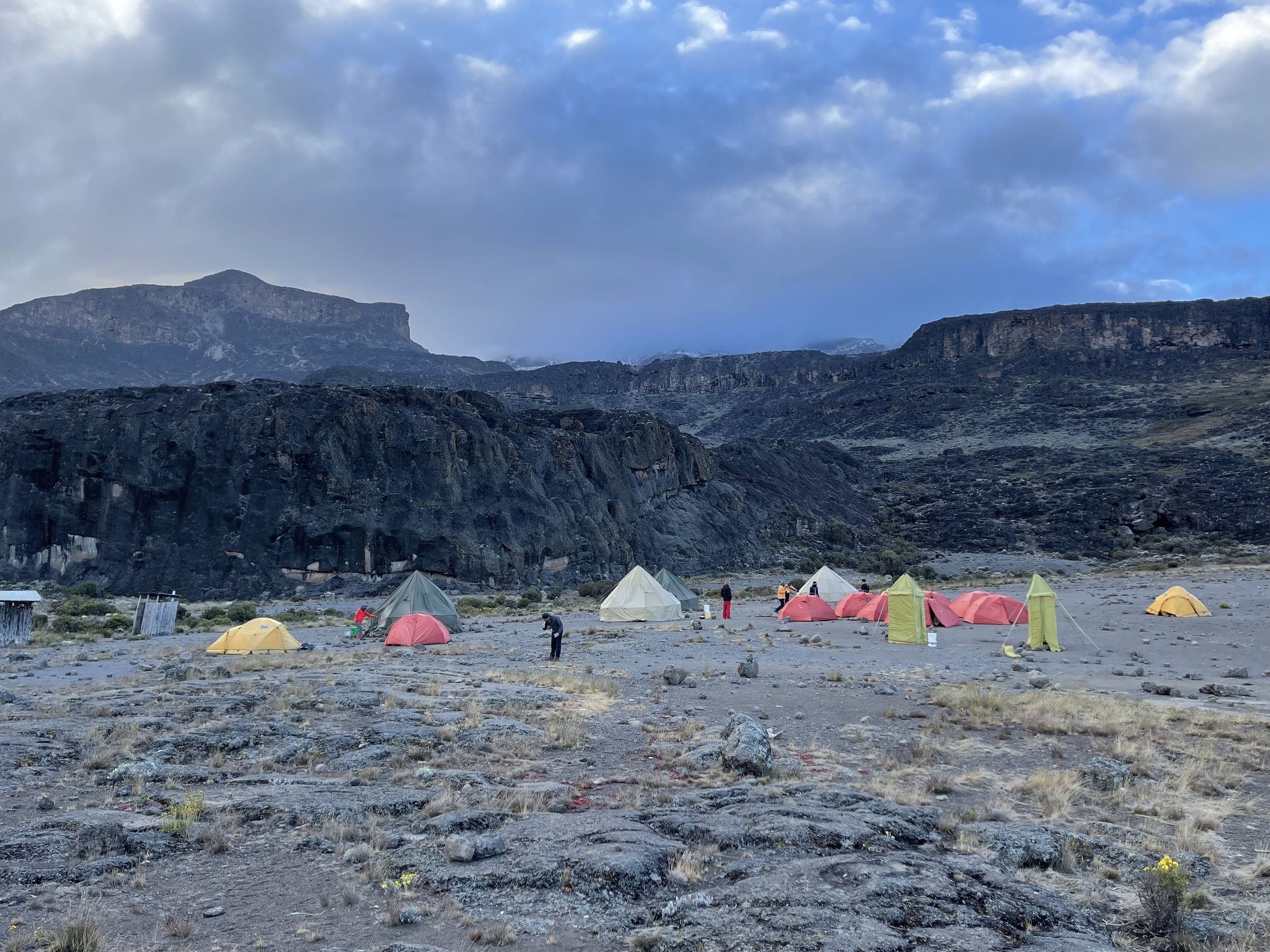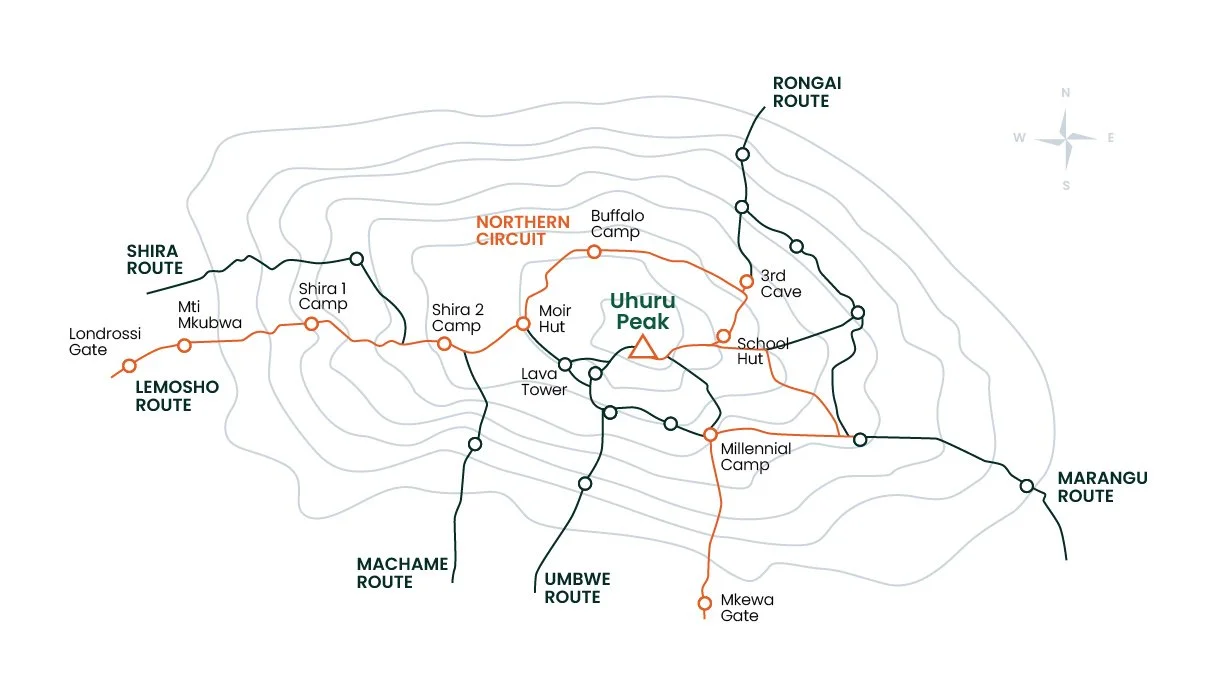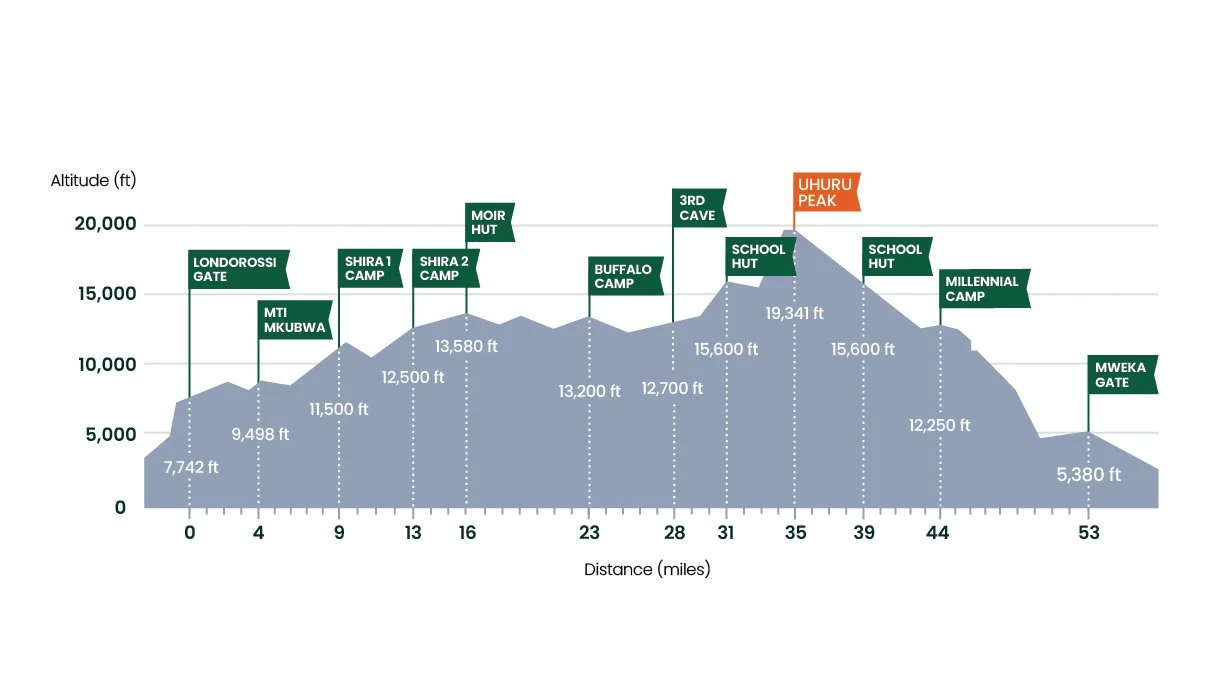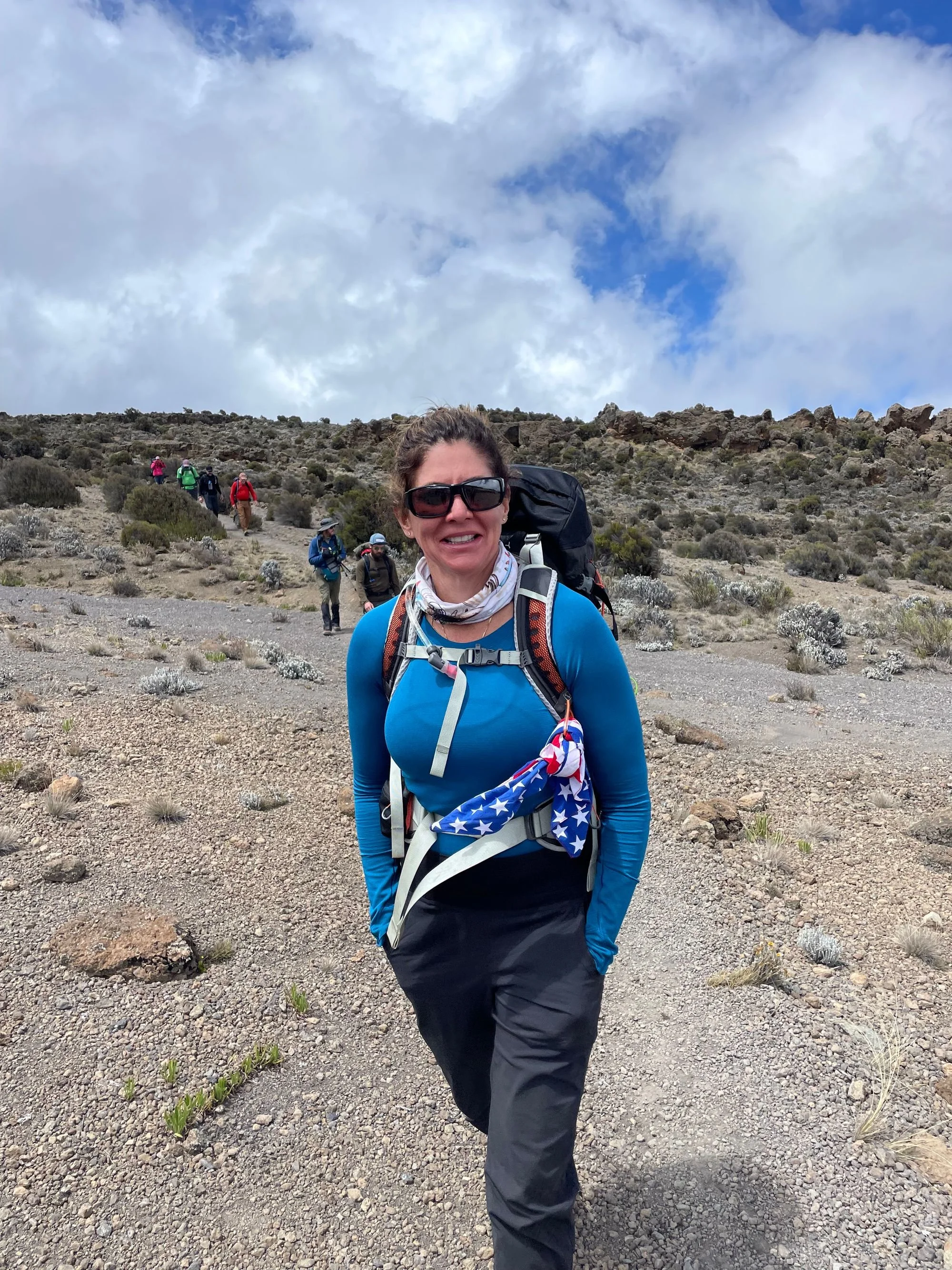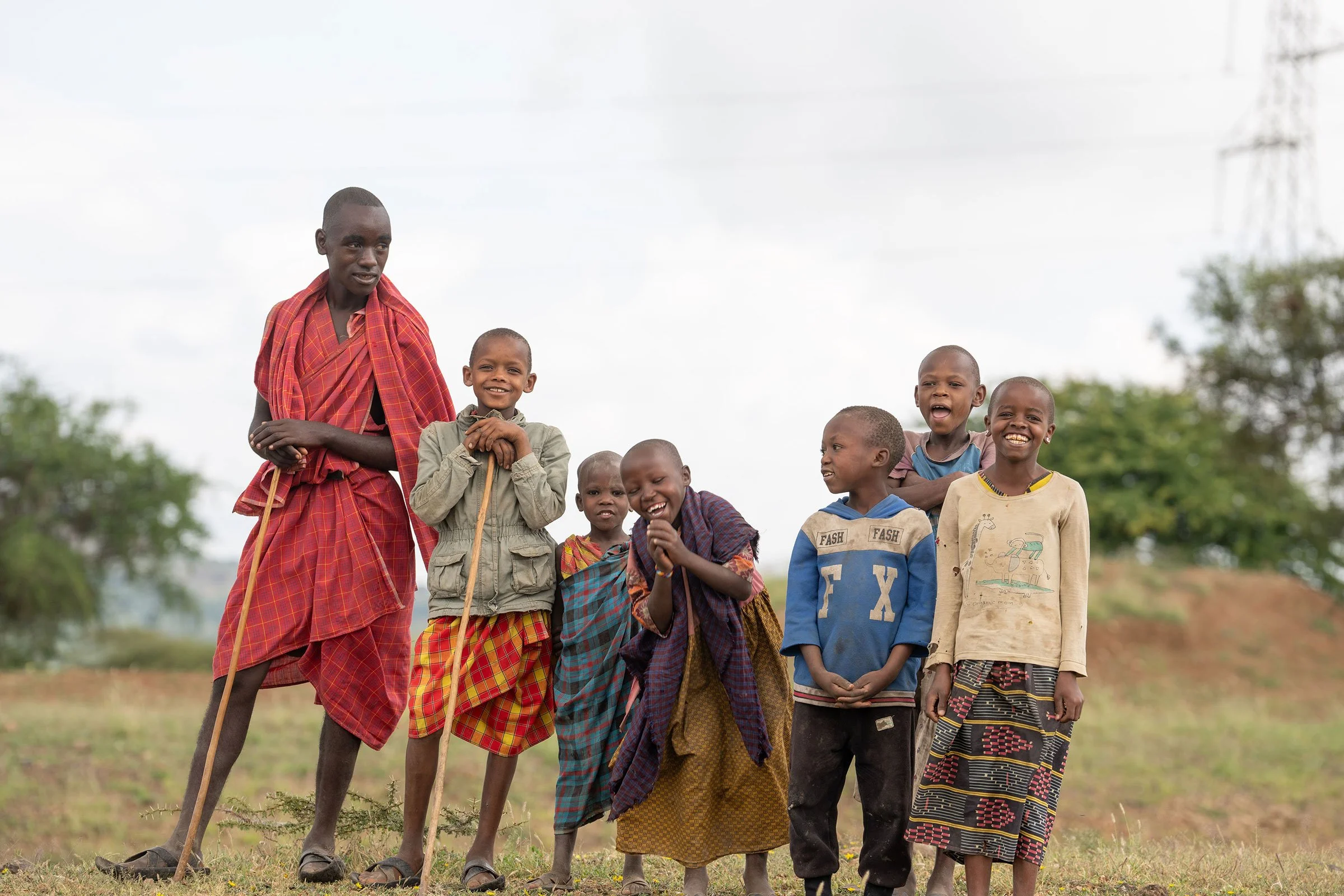
Mt. Kilimanjaro Expedition
Destination
Africa - Tanzania
Activity
High-altitude mountain trekking and driving safari
Terrain
Mountain
Duration
9 days on the mountain, 5 days on safari
Kilimanjaro & Safari
JANUARY 1 - JANUARY 13, 2025
Imagine traveling over dry, arid African plains inhabited by large varieties of wildlife. Everything is flat, not a hill in sight, until Kilimanjaro. Considered one of the world’s most massive, extinct volcanoes, Kilimanjaro is a mountain all its own. With a vertical gain from the plains to the summit being over 15,000 ft., Kilimanjaro is the world’s highest freestanding mountain and is called the Roof of Africa. With an unprecedented elevation gain, climbing Kilimanjaro is a spectacle of diversity as one traverses its many ecosystems and climactic changes. Enhanced with complex volcanic geology and glaciations, Kilimanjaro is a brilliant encounter with the mystery and awe of nature. Our extraordinary team is further enhanced by the inclusion of a certified Yoga instructor. She will provide all the physical and spiritual benefits of yoga practice in the wilderness. Complete your cultural immersion on a safari tour while experiencing the wonders of the Serengeti, home to all of Tanzania's most iconic animals and the great migration. Travels include the Olduvai Gorge – a world heritage site and home to Leakey’s discoveries, and the Ngorongoro Crater - the world's largest inactive, unbroken and unfilled volcanic caldera!

The Northern Circuit

“It was beautiful and magical and the hardest and most humbling thing I have ever done”

Trip Details
-
The aim of this expedition is to trek to the summit of Mt Kilimanjaro - a journey of about 90km - on foot, followed by a 5-day driving safari.
With 5 different ecological climate zones, Kilimanjaro is one of the most unique, and most attempted of the 7 Summits. It is also the tallest freestanding mountain in the world and is called the “Roof of Africa”.
Our team will follow the Lemosho Route along the mountain’s northern circuit. As Kilimanjaro’s longest route, our teams have an excellent chance to fully acclimatize to the altitude. During our climb the team will be fully supported by Endeavor’s leaders and more than 50 local staff members including guides, porters, cooks, and other staff.
After departing Kilimanjaro, our team will fly to the Serengeti and embark on an epic 5-day driving adventure. We will search for Africa’s “big 5” and enjoy luxury accommodations.
-
• Trek to the summit of the tallest mountain in Africa, and the tallest freestanding mountain in the world
• Enjoy the wonders of the 5 ecosystems of the mountain
• Bond with our African friends and the Endeavor team, securing lasting friendships and camaraderie
• Optional daily yoga, led by Endeavor’s renowned international yoga instructor
• Camp under the brilliant skies of East Africa
• Seek out the African “big 5” in the Serengeti on safari
• Fully immerse in African culture while visiting a Maasai Boma (village)
-
Over decades of travel and expeditions, Endeavor’s leaders have learned two constants – expedition schedules change and our western obsession with clocks (and smart phones) disappear. As such, the following plans are offered as a framework without specific timings. A full itinerary is provided upon application to a team!
On Arrival
Arriving at Kilimanjaro International Airport on Day 1, team members will be greeted by our staff and transferred to the team hotel. Day 2 starts with rest and recovery from jet lag; the afternoon includes a team welcome and briefing, yoga class (help relieve jet lag), gear check, and team dinner. We depart for Kilimanjaro early the next morning to begin our extraordinary expedition.
On Kilimanjaro
Over the next 9 days, we will follow the Lemosho Route along the northern circuit to the summit, one of the least travelled routes on Kilimanjaro. It is also the longest route at around 90 km, allowing the team a good chance to fully acclimatize. Our support team leads the way, establishing daily camps along our route and providing three hot meals. Carrying only our daypacks, we follow our guides for about 4–7 hours each day, experiencing the extraordinary and varied biomes of Kilimanjaro. Upon reaching the summit, we descend to the Mweka Gate to celebrate with our team our once-in-a-lifetime achievement.
On Safari
After reaching the Roof of Africa, we complete our cultural immersion on a driving safari tour while experiencing the wonders of the Serengeti, home to all of Tanzania's most iconic animals. Traveling for 5 days in safari jeeps and supported by certified guides, we travel across the Serengeti from lodge to lodge enjoying traditional meals and beautiful cultural settings. Travels include the Olduvai Gorge – a world heritage site and home to Leakey’s discoveries, and the Ngorongoro Crater - the world's largest inactive, unbroken, and unfilled volcanic caldera!
After traveling back to Arusha, our expedition officially ends on Day 17 with team members being transported Kilimanjaro International airport to begin travel home.
-
Our extraordinary team is further enhanced by the inclusion of a certified Yoga instructor. Endeavor’s Co-Founder – Kristi Sumpter, will provide all the physical and spiritual benefits of a yoga practice in the wilderness.
Yoga Offerings (optional) - in addition to our climb
Post-travel (70 minute) yoga class to help relieve jet lag
Morning mountain pre-trek sun salutations to include dynamic yoga stretches with trekking poles
Afternoon mountain post-trek yoga cool downs, including restorative stretches with yoga straps
Potential chair yoga in community tent during inclement weather
Yoga potentially provides the following benefits:
Improves concentration and endurance while climbing
Builds pre-trek energy by igniting the agni (fire) in the body
Provides cooling effects for post-trek recovery
Strengthens ligaments and tendons allowing for greater balance on uneven terrain
Supports high altitude lung function, blood pressure and brain function
Provides improved circulation to all fatigued extremities during treks
-
Endeavor’s treks are attainable by anyone possessing a solid level of fitness and generally sound degree of health. With that said, our expeditions require strength and endurance. The better your physical condition, the more likely you are to perform well and have an enjoyable experience.
Kilimanjaro, at 19,341ft., is a challenging, high-altitude climb and is perhaps the most underestimated of the seven summits. Most people will need to train specifically for climbing Kilimanjaro for at least three to four months and should focus on the following requirements:
Activity – you should be comfortable walking 4 to 8 hours per day
Carry- your backpack will normally not exceed 10-12lbs.
Climate – highly dependent on the season and altitude, the climate on Kilimanjaro varies greatly and can change mid-day. Temperatures on the summit can range at night between 20 and -20 degrees Fahrenheit.
Terrain – rocky paths and loose scree (descent)
We have found from past team members that climbers who prioritize their training efforts in the following ways maximize their experience and enjoyment on the mountain:
1. Climbing Kilimanjaro conditioning – pack-loaded uphill hiking, walking, and stair-climbing
2. Strength training — for the lower body and core
3. Cardiovascular training — including both aerobic and anaerobic workouts, without pack weight
4. Flexibility training
We highly recommend checking with your physician before undertaking any strenuous activity.
-
What is included:
Lodging at the following or similar locations:
Africa Amini Lodge
Acacia Migration Camp
Mbugani Migration Camp
Bougainvillea Lodge
Airport transfers to and from Kilimanjaro International Airport – JRO
Transportation to and from Kilimanjaro and safari
Park fees, and climbing permits
All food in camps
All food on the safaris and upon arrival at the Africa Amini Lodge
InReach- Garmin for emergency use
Tents, stoves, and mountain equipment (non-personal)
Local mountain staff; porters, cooks, and English-speaking guides
Kilimanjaro climbing staff tips only
What is not included:
International airfare
Tanzania visas
Meals while traveling and in cities in Tanzania or days outside the expedition program
Personal expenses: laundry, telephone, drinks, and shopping
Personal equipment including gear rentals
Trip Insurance (cancellation and medical) – HIGHLY RECOMMENDED
Local, drivers, staff, and Endeavor Expedition and Exploradus guide tips
Kids of Kilimanjaro
Learn more about our nonprofit organization that helps bring education access to the children of the guides and porters of Kilimanjaro.
Explore - Discover - Immerse
Photos by modus photography

FAQ
-
As common in many third-world countries, phone signal and remote internet access in Tanzania is spotty. Most hotels have some Wi-Fi. You should check with your U.S. phone provider to determine your access to international roaming – these services can be expensive. However, phone signal on the mountain is quite spotty; you should not expect to have signal while on Kilimanjaro or during the driving portion of the safari. Endeavor leaders carry InReach- Garmin devices for emergency use.
Note – Tanzania announced in 2022 that new Wi-Fi service was installed on Kilimanjaro. However, other teams have noted that coverage is not complete, so our recommendation remains to not plan for Wi-Fi or phone signal during the climb.
-
Our support team on Kilimanjaro includes a ‘toilet crew’, comprising of two camp toilets that will be set-up at each campsite. During the day and while trekking on the mountain nature will be your bathroom. All toilet paper or wipes must be packed off the mountain as we strive to keep the environment pristine! Private toilets and showers are available at all hotels before our trek and during the driving safari.
-
Caution and care should be always exercised by travelers in foreign countries. However, Endeavor and Exploradus have been visiting Tanzania for over 20 years and find the people to be friendly, generous, and deeply appreciative of the tourist business we bring to their country. All teams are met upon arrival at Kilimanjaro International Airport and transported by guides and local staff to and from all destinations during the expedition. Further, Endeavor constantly monitors conditions in all countries we operate in and communicate directly with team members any concerns and contingency plans. We also direct team members to online links for travel updates from the local U.S. Embassy, as well as emergency contact numbers used during the expedition.
-
Team members should bring portable chargers/travel-banks to use while on Kilimanjaro. Travel converters should also be in your kit. There are two associated plug types used in Tanzania – types D and G. Tanzania operates on a 230V supply voltage and 50Hz.
-
Upon confirmation of a team slot, members receive a detailed gear and packing list for the expedition. Selection of items is based on critical need, weight, and decades of experience in the field and on this trek. Endeavor provides personal assistance in gear recommendations and proper use and fit; inspections are held before departing the U.S. and in Tanzania the day before we begin our climb.
-
The official Kilimanjaro National Park weight limit for the amount porters can carry is 20kg/44lbs. This regulation was established to protect the health of the porters, and Endeavor strictly adheres to this limit. This applies to the items in your duffle bag, and weight checks are conducted by Endeavor at the team hotel, and Park officials on the mountain.
-
Team members only carry a day-backpack as our support team porters carry your duffel bag. Your daypack will comprise primarily of rain gear, drinking water, extra clothing, and cameras or other personal items (snacks). While most team member’s packs only comprise 10-12lbs. we recommend backpacks that have solid shoulder straps and waist belts to accommodate comfort and support. The optimal size (volume) backpack is 30 to 40 liters.
-
Team members should fly into Kilimanjaro International Airport (JRO) and plan travel dates according to the expedition schedule. Direct connections to JRO are available from several cities, including Delta’s direct route from Amsterdam. We will strive to provide assistance in booking recommendations and travel questions. Meals and lodging are covered as part of the program cost only during the expedition program; members are responsible for all other costs for days before or after the program.
-
Including snakes, there are no dangerous animals on Kilimanjaro. You may be entertained by some noisy monkeys in the lower camp, but animals and trees largely disappear as you ascend higher in elevation on the mountain.
-
All meals on the trek and during the safari are provided. Any dietary restrictions and food allergies should be communicated in advance of the program to allow time for our team to make necessary adjustments. Meals during personal travel or days outside the expedition program are not provided.
-
Kilimanjaro's altitude is a significant challenge, but climbers do not need supplemental oxygen to climb Kilimanjaro or reach the summit. To reach to the summit you use the acclimatization method of walking slowly “pole pole” and climb high, sleep low.
-
Your trekking hours hugely depend upon the route, pace, and the day, but the average trek is around 4 to 7 hours. Team members can proceed at their own pace as we provide enough guides to support smaller groups of climbers moving at their own speed. Ideally, our days begin each morning around 8:00 and 8:30 a.m. Summit Day is the longest of the 9 days though our pace is very slow and methodical; we begin our push for the summit at midnight and normally reach the summit in 7 to 8 hours, followed by another 6+ hour descent to our next camp.
-
Due to its closeness to the equator, Mount Kilimanjaro doesn't experience wide temperature changes from season to season. And Mount Kilimanjaro's great height means the mountain creates its own weather. Our July expedition is during the long dry season, which is a great time of year to climb the mountain. Temperatures are a little colder than the short dry season (January and February) but overall conditions are excellent with low chances of precipitation. At the summit, Uhuru Point, the night-time temperatures can range between 20 and -20 degrees Fahrenheit.
